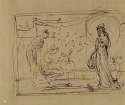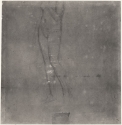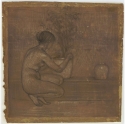
Composition
It is difficult to reconstruct the exact appearance of The Three Girls [YMSM 088] but the pen drawing in the Hunterian, the small oil sketch (The White Symphony: Three Girls [YMSM 087]), and the large painting of the central figure (Girl with Cherry Blossom [YMSM 090]) appear to correspond closely to each other, while the copy (Pink and Grey: Three Figures [YMSM 089]) shows some variations and may have been later altered by the artist.
The pen drawing, Study of 'The Three Girls' [M.0361], shows two details not incorporated in the oil versions, in that both flower pots are round instead of straight sided, and that it is signed with a butterfly of about 1871/1874 (the oil sketch, The White Symphony: Three Girls [YMSM 087], has the rectangular field but no butterfly).
DRAWINGS:
According to T. R. Way, 'numberless studies' were drawn in preparation for The Three Girls [YMSM 088] . 1
There are numerous drawings for the composition, which are discussed in relation to The White Symphony: Three Girls [YMSM 087], but also relate to this enlarged version of the composition, The Three Girls [YMSM 088]. These include A nude holding up a parasol [M.0372] (reproduced above), Nude with parasol [M.0371], and another Nude with parasol [M.0373] (seen above).
Several of the early studies for the nude with the parasol are on the back of other drawings. 2 Pinholes in the paper suggest that some were pinned up for reference more than once but it is impossible to tell which side was being consulted.
One sheet dating from 1869/1870 contains two drawings: r.: Crouching figure in 'The White Symphony: Three Girls'; v.: Standing figure in 'The White Symphony: Three Girls' [M.0359]. It has a partial sketch of the standing figure on one side, and an elaborately finished one of the central figure on the other.
There are numerous drawings for the figure on the left, some of which could well be studies for a closely related drypoint, Tillie: A Model [113]. These include Tillie [M.0367], Study of a Nude [M.0368], Study for 'Tillie: A Model' [M.0369] (reproduced above), and Tillie: Study in Pink and Mauve [M.0370]. Some of these were reworked later; Tillie: Study in Pink and Mauve was completed and signed in 1890.
T. R. Way, who was in and out of Whistler's studio in the late 1870s, wrote later, 'I saw at least three distinct variations in oil sketches, and an immense number of drawings of the various figures in black and white and pastel on brown paper, some in the nude, some with drapery added.' 3
Technique
There is no information about Whistler's technique except that it involved repeatedly rubbing down the entire canvas.
Arrangement in Grey and Black: Portrait of the Painter's Mother [YMSM 101] has been relined so it is impossible to substantiate Way's statement that Whistler originally drew a version of the design for The Three Girls [YMSM 088] on the canvas later used for Arrangement in Grey and Black: Portrait of the Painter's Mother [YMSM 101]. In size Arrangement in Grey and Black: Portrait of the Painter's Mother [YMSM 101] is 114.3 x 162.5 cm (56 ¾ x 64").
Whistler said that he painted a copy (Pink and Grey: Three Figures [YMSM 089]) of The Three Girls [YMSM 088] 'on the same size canvas' – that is, 139.7 x 185.4 cm (55 x 73") . 4
Girl with Cherry Blossom [YMSM 090], which may well have once formed the central section of The Three Girls [YMSM 088], is close to Arrangement in Grey and Black: Portrait of the Painter's Mother [YMSM 101] in height, being 139.2 cm (54 ¾").
Conservation History
The painting was probably destroyed by the artist. It is likely that Girl with Cherry Blossom [YMSM 090] formed the central section of the canvas.
Frame
The original frame, designed and painted by Whistler about 1872/1873, was given in 1879 to The Gold Scab [YMSM 208], which measures 186.7 x 139.7 cm (73 1/2 x 55").
Notes:
1: Way & Dennis 1903 [more] , p. 30.
2: r.: Inspiration; v.: A nude with a parasol and a jug [M.0358], r.: Crouching figure in 'The White Symphony: Three Girls'; v.: Standing figure in 'The White Symphony: Three Girls' [M.0359], r.: A Japanese Woman; v.: Girl with parasol [M.0458].
4: Whistler to Helen Whistler (Mrs W. Whistler), [22 March 1880], GUW #06688.
Last updated: 1st June 2020 by Margaret
















